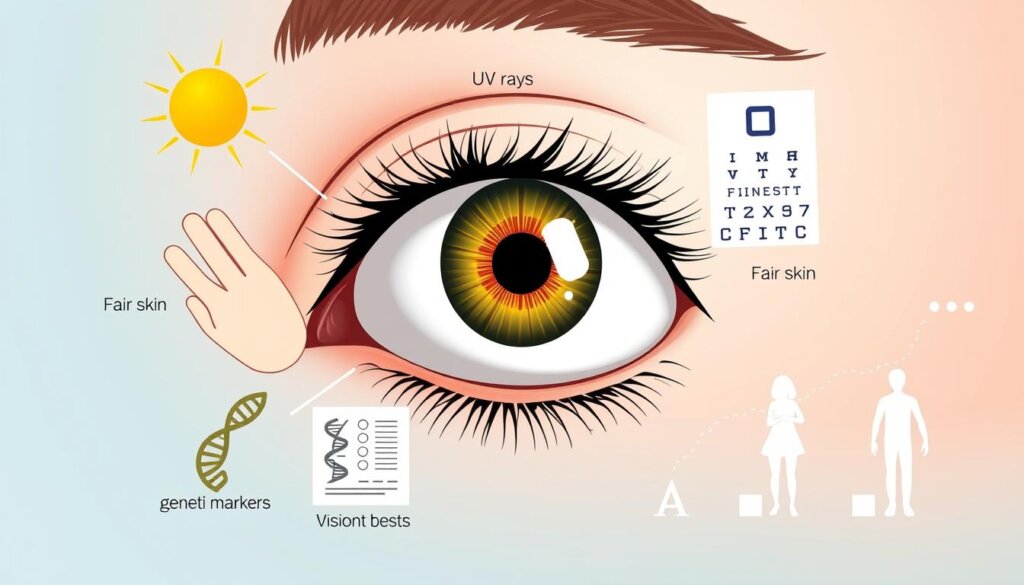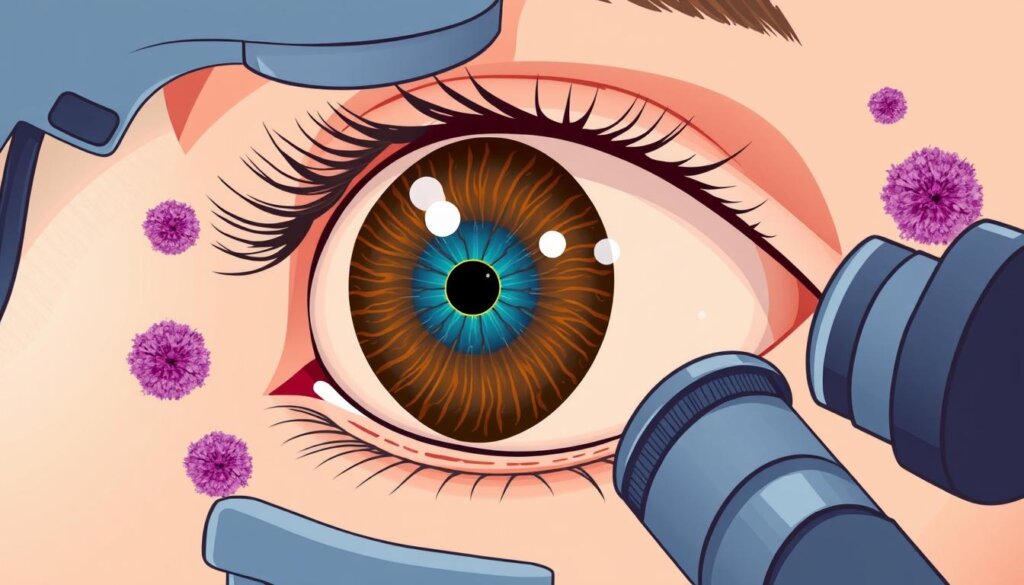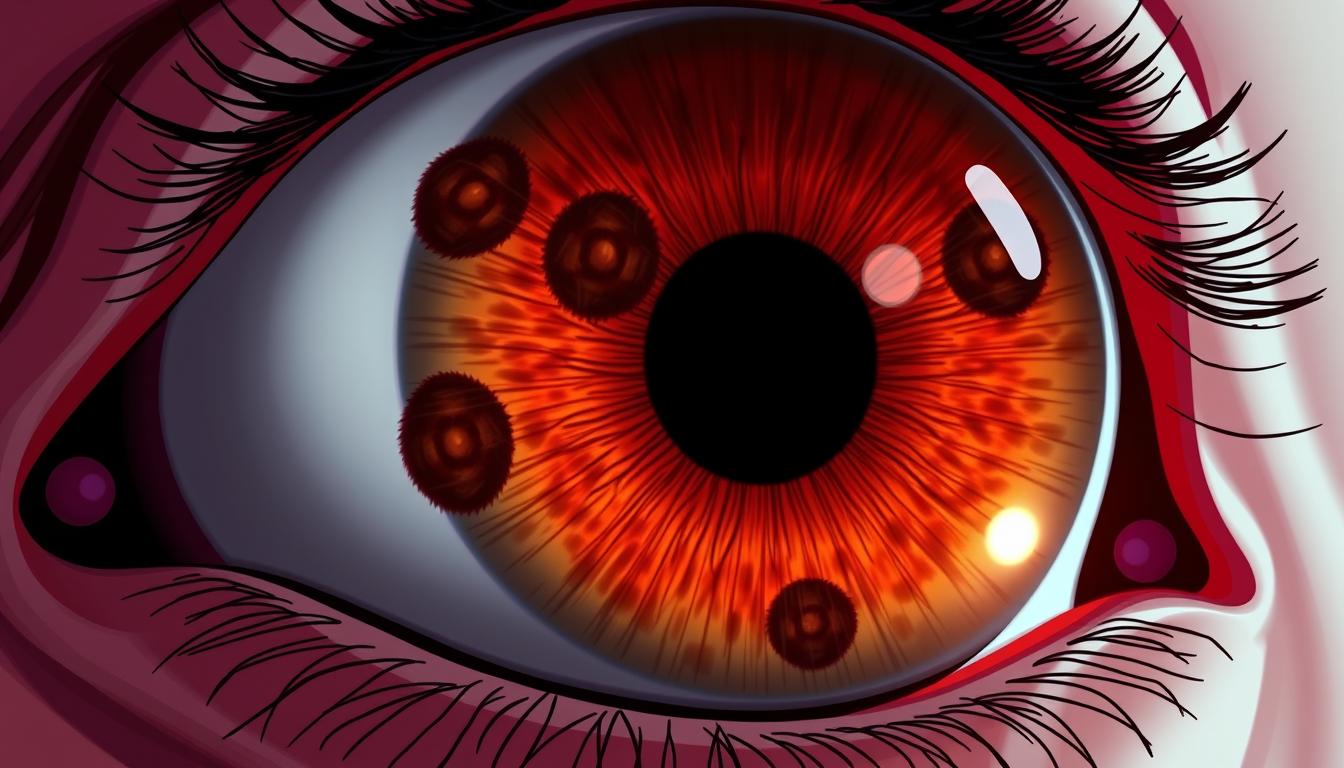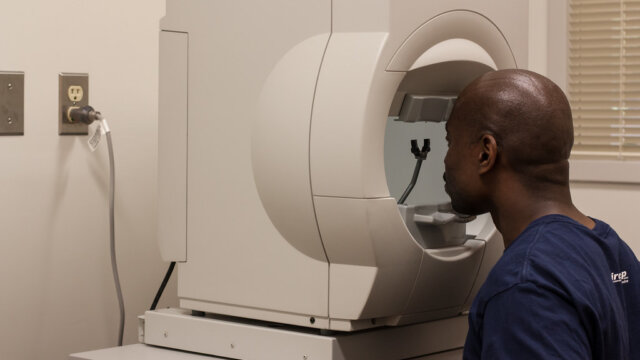FTC disclaimer: This post may contains affiliate links and we will be compensated if you click on a link and make a purchase.
Intraocular melanoma is a common eye cancer in adults. It’s a serious condition that affects the middle layer of the eye. This includes the iris, ciliary body, and choroid. It can cause big vision problems and even spread to places like the liver.
Since it’s a complex disease, it’s often hard to notice. Knowing about its causes, risks, and treatments is key. It helps protect your eye health and vision.
Key Takeaways
- Intraocular melanoma is the most common type of eye cancer in adults.
- It affects the uvea, the middle layer of the eye, including the iris, ciliary body, and choroid.
- Intraocular melanoma can lead to vision loss and spread to other parts of the body, particularly the liver.
- Understanding the causes, risk factors, and treatment options is crucial for managing this vision-threatening condition.
- Early detection and proactive care are essential for preserving eye health and vision.
What is Intraocular Melanoma?
Intraocular melanoma is a type of eye cancer. It grows in the melanin-producing cells of the eye. It often affects the uvea, which is the middle layer of the eye.
This layer includes the iris, ciliary body, and choroid. But it can also happen in the conjunctiva or eyelid, though this is rare.
Defining Intraocular Melanoma
Intraocular melanoma starts in the eye’s melanin-producing cells. It’s the most common eye cancer in adults. It can grow in different parts of the eye, leading to different types of the disease.
Types of Intraocular Melanoma
The main types of intraocular melanoma are:
- Choroidal melanoma, which grows in the choroid layer at the back of the eye.
- Iris melanoma, which happens in the colored part of the eye.
- Ciliary body melanoma affects the muscle fibers around the lens.
Intraocular melanoma can also occur in the conjunctiva or eyelid, though this is less common.
Knowing the different types of intraocular melanoma is key for correct diagnosis and treatment. Each type needs a specific care plan.
Risk Factors for Intraocular Melanoma
Intraocular melanoma is a rare and serious eye cancer. Studies have shown that certain factors can increase the risk of this condition.
One key risk factor is light eye color. People with blue or green eyes are more likely to get uveal melanoma than those with darker eyes and skin. Also, being Caucasian raises the risk of eye melanoma more than for African Americans, Hispanics, or Asian Americans.
The risk goes up with age. Males are slightly more at risk than females. Certain inherited skin conditions, like dysplastic nevus syndrome or oculodermal melanocytosis, also increase the risk of eye cancer.
- Genetic mutations, like those linked to BAP1 cancer syndrome, can also raise the risk of uveal eye melanoma and other aggressive cancers.
- Certain eye or skin moles are linked to a higher risk of uveal eye melanoma.
- The role of sun exposure as a risk factor for uveal or conjunctival melanoma is still being researched. But, welders might have a higher risk, especially in the choroid and ciliary body.
The link between skin melanoma and eye melanoma risk is still unclear. Researchers are studying how different factors affect the risk of intraocular melanoma.
Risk Factor | Description |
|---|---|
Light Eye Color | People with blue or green eyes are more likely to get uveal melanoma. |
Caucasian Race | White people face a higher risk of eye melanoma than African Americans, Hispanics, or Asian Americans. |
Increasing Age | The risk of eye melanoma increases with age, with males slightly more prone than females. |
Inherited Skin Conditions | Conditions like dysplastic nevus syndrome or oculodermal melanocytosis can increase the risk of eye melanoma. |
Genetic Mutations | Certain genetic mutations, such as those associated with BAP1 cancer syndrome, can predispose individuals to uveal eye melanoma and other aggressive cancers. |
Moles in the Eye or Skin | Certain types of moles in the eye or on the skin have been linked to a higher risk of uveal eye melanoma. |
UV Exposure | The role of sun exposure as a risk factor for uveal or conjunctival melanoma is inconclusive and requires further research, but welders might have a higher risk. |
Skin Melanoma | The relationship between skin melanoma and eye melanoma risk is uncertain. |
Knowing these risk factors helps identify those at higher risk of intraocular melanoma. This leads to early detection and proper management of this serious condition.

Symptoms of Intraocular Melanoma
Early Signs and Symptoms
In the early stages, intraocular melanoma might not show any symptoms. But as it grows, symptoms can appear. These include seeing flashes or specks (floaters), a dark spot on the iris, and changes in the pupil’s shape.
Advanced Symptoms
When intraocular melanoma gets worse, symptoms get more serious. You might see blurry or lost vision, lose part of your side vision, or have a bulging eye. Eye pain or redness can also happen. Sometimes, vision can suddenly go away because of the tumor.
It’s key to know these symptoms can also mean other eye problems. Regular eye exams and quick medical help are vital for catching it early and treating it right.
Early Symptoms | Advanced Symptoms |
|---|---|
|
|

“Early detection is key for managing intraocular melanoma. Paying attention to changes in your vision or eye appearance can help identify the condition before it progresses.”
Intraocular melanoma is the most common eye cancer in adults, but it’s still rare. People with light-colored eyes and fair skin are more likely to get it. It usually affects those in their mid-50s.
Diagnosis of Intraocular Melanoma
Diagnostic Tests and Procedures
Finding intraocular melanoma starts with a detailed eye check. Doctors use special tools to spot and check the tumor.
Ophthalmoscopy lets doctors see inside the eye. It helps find and understand the melanoma.
Imaging tests like ultrasound, CT scans, and MRI help see the tumor’s size and where it is. Ultrasound is often used to confirm the diagnosis.
Tools like optical coherence tomography (OCT) and fluorescein angiography give more details. They help doctors see the eye’s structures and blood vessels.
At times, a biopsy is needed. It takes a tissue sample for analysis and to plan treatment.
It’s important to find intraocular melanomas early. They are easier to treat then. Regular eye checks help catch them early and improve treatment.

Diagnostic Test | Purpose |
|---|---|
Ophthalmoscopy | Visual examination of the inside of the eye |
Ultrasound | Confirm diagnosis, provide information on tumor location and size |
Optical Coherence Tomography (OCT) | Detailed imaging of the back of the eye |
Fluorescein Angiography | Visualize blood vessels in the eye for differential diagnosis |
Biopsy | Obtain tissue sample for analysis and treatment planning |
Treatment Options for Intraocular Melanoma
If you have intraocular melanoma, your treatment will depend on several things. These include the tumor’s size and where it is, and your health. Your healthcare team will help choose the best treatment for you. Common treatments include:
- Active Surveillance or Watchful Waiting: For small, slow-growing tumors, your doctor might suggest waiting and watching. This means regular eye exams and tests to check the tumor.
- Surgery: Removing the tumor or the whole eye might be needed for bigger tumors.
- Radiation Therapy: This treatment, like plaque brachytherapy or external beam radiation, is used for small to medium-sized tumors.
- Laser Therapy: Laser treatments can destroy smaller tumors. They might be used alone or with radiation therapy.
Your healthcare team will look at the good and bad of each treatment. They will also think about your age, health, and what you prefer. This helps them make the best plan for you.
Treatment Option | Description |
|---|---|
Radiation Therapy | Used for small to medium-sized tumors. It uses high-energy beams like protons or gamma rays. |
Proton Therapy | A type of radiation therapy for eye melanoma. |
Enucleation | Removing the whole eye, often for large tumors. |
Photodynamic Therapy | Good for smaller tumors, not for bigger ones. |
Cryotherapy | Extreme cold treatment for small eye melanomas. |
Your healthcare team will make a treatment plan just for you. They will talk to you about your needs and what’s best for you. If you have questions or worries, ask your doctor.
New treatments for intraocular melanoma are being found all the time. Your healthcare team will keep up with these new things. They will give you the best care for your condition.
Active Surveillance and Watchful Waiting
For those with small, slow-growing intraocular melanomas, active surveillance or watchful waiting might be suggested. This means keeping a close eye on the tumor without immediate treatment. It’s considered when the tumor is tiny, doesn’t affect vision, or if it’s unsure if it’s cancer.
When is Active Surveillance Recommended?
Active surveillance is suggested for small, slow-growing tumors. Regular eye exams and imaging like ultrasound or MRI track the tumor’s changes. This way, the team can watch the tumor closely and start treatment if needed, avoiding harsh side effects.
It’s a good option for older patients or those with health issues that make treatment risky. It aims to weigh the benefits of treatment against the risks to quality of life. Those on active surveillance need regular check-ups to keep the tumor stable or prevent it from getting worse.
However, cancers thought to be slow might grow faster or spread, needing a change in treatment. So, patients on active surveillance must stay alert and work closely with their team for timely action if needed.
Surgical Intervention for Intraocular Melanoma
Surgery is a key treatment for intraocular melanoma. The surgery type depends on the tumor’s size, location, and stage. The doctor might remove just the tumor or the whole eye to get rid of the cancer.
In some cases, the doctor may also take out the eyelid or eye muscles. This is to make sure all cancer is gone. The surgery method changes based on the tumor’s shape and size.
Intraocular melanomas from certain parts of the eye are more likely to spread. This means the 5-year survival rate is about 30% if the cancer spreads.
For smaller tumors, the doctor might just take out the tumor and a bit of tissue around it. This helps keep the eye working while treating the cancer.
But for bigger tumors or those that have spread, removing the eye might be needed. This ensures all cancer cells are gone and stops it from spreading.
Dealing with intraocular melanoma surgery is very important. The doctor’s skill and the patient’s situation help decide the best surgery. This aims for the best results.
Radiation Therapy for Intraocular Melanoma
Radiation therapy is a common treatment for intraocular melanoma. It’s a non-invasive method that can be very effective. There are two main types: plaque brachytherapy and external beam radiation.
Types of Radiation Therapy
Plaque Brachytherapy: A small radioactive disc, called a plaque, is placed on the eye. It emits radiation directly to the tumor. This method can cure about 9 out of 10 small to medium-sized tumors.
It’s as effective as removing the eye to treat the cancer.
External Beam Radiation: This method uses a machine to send high-energy beams into the eye. Proton beam radiation therapy can target the tumor better while harming less of the eye.
But, it’s not as common as brachytherapy or external beam radiation for treating eye melanomas.
Radiation therapy can cause side effects like blurry vision and dry eye. Other issues include cataracts, retinal detachment, and glaucoma. It can also lead to loss of eyelashes and bleeding in the eye, depending on the tumor’s size and location.
“Radiation therapy is a crucial component in the comprehensive treatment of intraocular melanoma, offering effective and targeted options to address this complex eye cancer.”
Radiation therapy is key in treating intraocular melanoma. It provides effective treatment options. These can help keep the eye and vision in many patients.
Preventing Intraocular Melanoma
There’s no surefire way to stop intraocular melanoma, but you can lower your risk. One key step is to cut down on UV exposure. UV rays can lead to this rare eye cancer.
- Always wear sunglasses with 99-100% UVA and UVB protection outside. This protects your eyes from UV harm.
- Stay away from tanning beds and other UV light sources. They raise your risk of intraocular melanoma.
- Live a healthy life by being active, eating well, and managing stress. These actions can lower your cancer risk.
Seeing an eye doctor regularly is also key. It helps spot eye issues early. People with light eyes, fair skin, or a family history of ocular melanoma should see doctors more often. Being careful and proactive can protect your eyes and catch melanoma early.
“The best way to prevent eye melanoma is to avoid excessive UV exposure and get regular eye exams to detect any changes early on.”
While you can’t fully prevent intraocular melanoma, simple steps can help a lot. These actions can keep your eyes safe and lower your risk.
Conclusion
Intraocular melanoma is a rare but serious eye cancer. It needs careful attention and the right treatment. Knowing the risks, like light iris color and UV exposure, helps you watch your eye health closely.
Spotting symptoms early is key. Look out for vision changes, dark spots, and other eye issues. Thanks to new tools and treatments, doctors can create plans to save your sight.
While some cases spread, research keeps getting better. Working with your eye team helps you fight this disease. Early action and treatment are crucial for beating intraocular melanoma, eye cancer, and getting the best treatment options and prognosis.
FAQ
What is intraocular melanoma?
Intraocular melanoma is a type of eye cancer. It grows in the melanin-producing cells of the eye. Most often, it affects the uvea, the middle layer of the eye.
What are the main types of intraocular melanoma?
There are three main types of intraocular melanoma. Choroidal melanoma grows in the choroid layer. Iris melanoma occurs in the colored part of the eye. Ciliary body melanoma affects the muscle fibers around the lens.
What are the risk factors for intraocular melanoma?
Risk factors include light eye color and being Caucasian. Increasing age and certain inherited skin conditions also increase risk. Ocular melanocytosis and UV light exposure are other factors.
What are the symptoms of intraocular melanoma?
Early stages may not show symptoms. As it grows, symptoms can include flashes or specks in vision. A growing dark spot on the iris and pupil shape changes are also signs.
In advanced cases, symptoms include blurry or lost vision. You might also see loss of peripheral vision, bulging eyes, and eye pain or redness.
How is intraocular melanoma diagnosed?
It’s diagnosed through a detailed eye exam. This includes direct or indirect ophthalmoscopy and imaging tests like ultrasound or CT/MRI scans. Sometimes, a biopsy is needed to get a tissue sample.
What are the treatment options for intraocular melanoma?
Treatment options include active surveillance or watchful waiting for small tumors. Surgery to remove the tumor or the eye is also an option. Radiation therapy, like plaque brachytherapy or external beam radiation, is used. Laser therapy can also destroy the tumor.
When is active surveillance or watchful waiting recommended for intraocular melanoma?
It’s recommended for small, slow-growing tumors. These are tumors that don’t cause vision problems. Regular eye exams and imaging tests monitor any changes in the tumor.
What are the surgical options for intraocular melanoma?
Surgical options include removing the tumor and a small amount of surrounding tissue. Or, the entire eye may be removed (enucleation). The surgeon might also remove additional tissues like the eyelid or eye muscles.
What types of radiation therapy are used for intraocular melanoma?
Radiation therapy includes plaque brachytherapy. A small radioactive disc is placed on the eye next to the tumor. External beam radiation is also used. It directs high-energy beams into the eye.
How can intraocular melanoma be prevented?
Preventive steps include avoiding UV light from the sun or tanning beds. Wear sunglasses with 99-100% UVA and UVB protection outdoors. Regular eye exams help spot any unusual growth.








